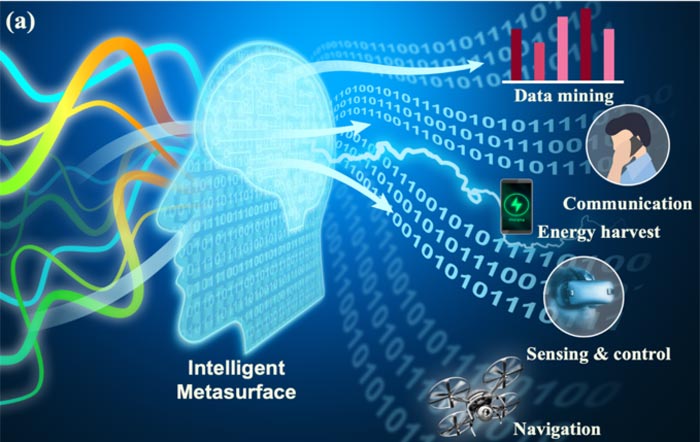Intelligent metasurface could revolutionize our lives

The intelligent metasurface, AI-empowered artificial material, is a smart platform enabling various functions such as data mining, communication, energy harvest, and sensing by directly processing illuminated information-carrying waves on the physical level.
Credit by Lianlin Li, Hanting Zhao, Che Liu, Long Li, and Tie Jun Cui
The manipulation of electromagnetic waves and information has become central to our daily lives. Intelligent metasurfaces have emerged as smart platforms for controlling the wave-information-matter interactions without manual intervention. They evolved from engineered composite materials, including metamaterials and metasurfaces. As a society, we have witnessed significant progress of metamaterials and metasurfaces with different forms and characteristics.
In a paper published in eLight, Professor Tie Jun Cui of Southeast University and Professor Lianlin Li of Peking University led a research team to review intelligent metasurfaces. “Intelligent metasurfaces: Control, Communication and Computing” investigated the development of intelligent metasurfaces with an eye for the future.
This field has refreshed human insights into many fundamental laws. They have unlocked many novel devices and systems, like cloaking, tunneling, and holograms. Conventional structure-alone or passive metasurfaces has moved towards intelligent metasurfaces by integrating algorithms and nonlinear materials (or active devices).
Intelligent metasurfaces have three crucial properties: digitalization, programmability, and intelligence. They provide an important opportunity to control the interactions without human intervention. Digitalization enables the metasurface to encode, decode and store digital information. Programmability means that the metasurface can realize distinct functions with one physical entity. Intelligence indicates that the intelligent metasurface can make decisions, self-program, and perform successive tasks without human supervision.
Intelligence is the core, and algorithms can take this role well. Artificial intelligence (AI) has developed rapidly, particularly in data mining and knowledge discovery. Deep learning has proven extraordinarily useful in nearly every field of science and engineering. Deep learning has significantly positively impacted the metamaterials and metasurfaces field. It will undisputedly give birth to comprehensive and active research directions.
In assessing the future of intelligent metasurfaces, the wireless signals that already exist in our lives could be vital to the field’s further development. The development of 6G wireless communications, green IoT, and digital twinning is where intelligent metasurfaces could benefit.
We can envision that intelligent metasurfaces can learn, make decisions, self-programming, and continuously learn throughout their ‘lifetime.’ The intelligent metasurface is an emerging research direction involving various disciplines. There are a lot of open questions needed to be carefully addressed in the future.
Journal: eLight
DOI: 10.1186/s43593-022-00013-3
Media Contact
All latest news from the category: Information Technology
Here you can find a summary of innovations in the fields of information and data processing and up-to-date developments on IT equipment and hardware.
This area covers topics such as IT services, IT architectures, IT management and telecommunications.
Newest articles

Innovative 3D printed scaffolds offer new hope for bone healing
Researchers at the Institute for Bioengineering of Catalonia have developed novel 3D printed PLA-CaP scaffolds that promote blood vessel formation, ensuring better healing and regeneration of bone tissue. Bone is…

The surprising role of gut infection in Alzheimer’s disease
ASU- and Banner Alzheimer’s Institute-led study implicates link between a common virus and the disease, which travels from the gut to the brain and may be a target for antiviral…

Molecular gardening: New enzymes discovered for protein modification pruning
How deubiquitinases USP53 and USP54 cleave long polyubiquitin chains and how the former is linked to liver disease in children. Deubiquitinases (DUBs) are enzymes used by cells to trim protein…



